A Guide to Semi Precious Stones
At Antique Jewellery Online we are proud to showcase some of the most striking and beautiful combinations of gemstones through the Georgian, Victorian, Edwardian and Art Deco periods. These pieces are so incredibly varied that they often contain stones which are less well known by the majority of people.
When people think of antique jewellery they tend to focus on diamonds, emeralds, sapphires and rubies, but there are a staggering array of less well known gems which come under the umbrella of semi precious stones. Whilst they may not have the same recognition at the “big four” they have been included in some truly magnificent pieces, and we’d like to help you to get to know them a little better.
Opal
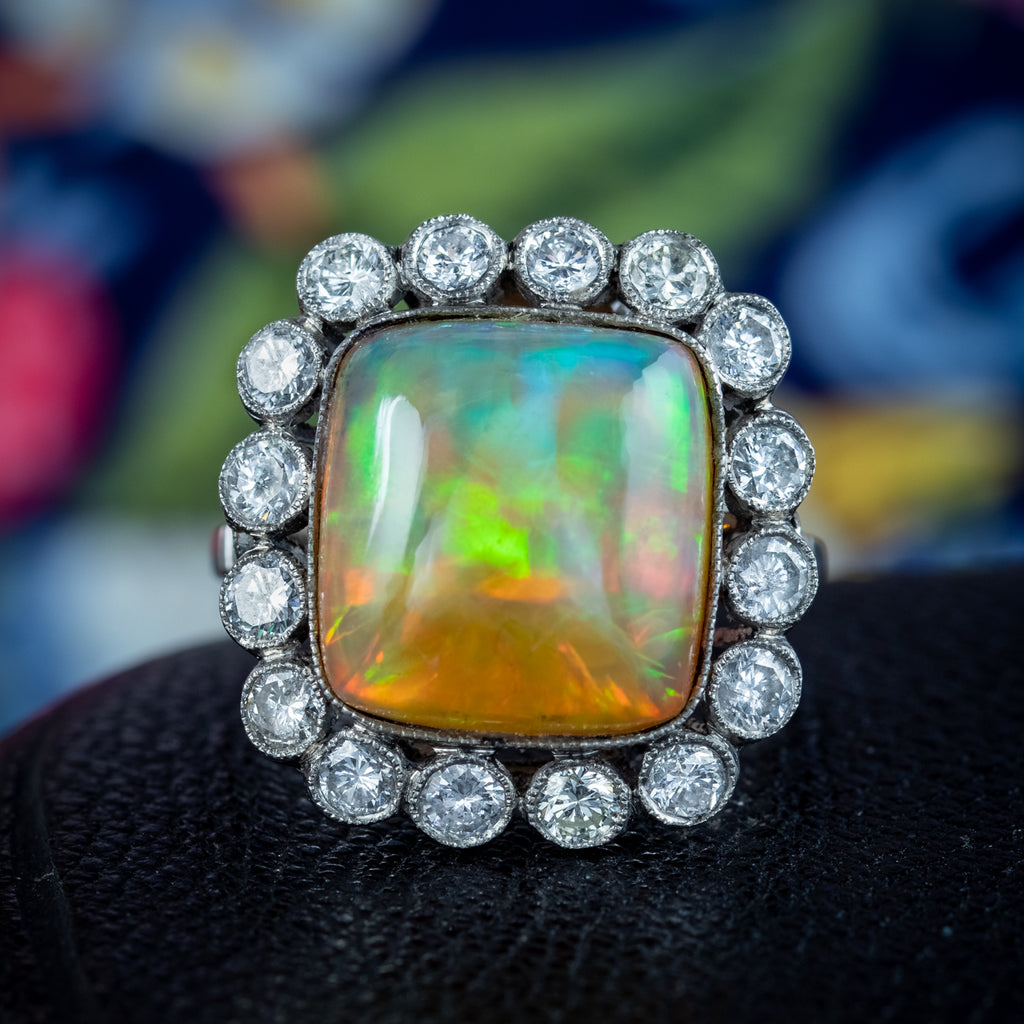
These multicoloured silica stones exhibit arguably the most elaborate plays of colour of any gemstone. “Opalescence”, as it is called, displays radically different colours in cascading swirls within the stone. There are many varieties of opal with wildly different colours and degrees of opalescence. They often form on the beds of ancient dried up riverbeds, and can form within fossilised organic material, leading to examples where bone and wood have been opalized.
Gem quality opals used in jewellery tend to be cut en cabochon (flat backed with a domed top) as this makes their unique characteristics as visible as possible.
You can view our collection of fine opal jewellery here.
Aquamarine

A light blue green variety of beryl, the same mineral that forms emeralds, aquamarines are often cut in the same way as their green cousins. Gem quality aquamarines are free from inclusions, and show a rich blue hue with flashes of green akin to the Caribbean ocean.
Large specimens can be found adorning many pieces of Art Deco jewellery, often paired with diamonds for added sparkle, and pale silver metals like white gold and platinum to match their cool tone.
You can view our collection of fine aquamarine jewellery here.
Amethyst
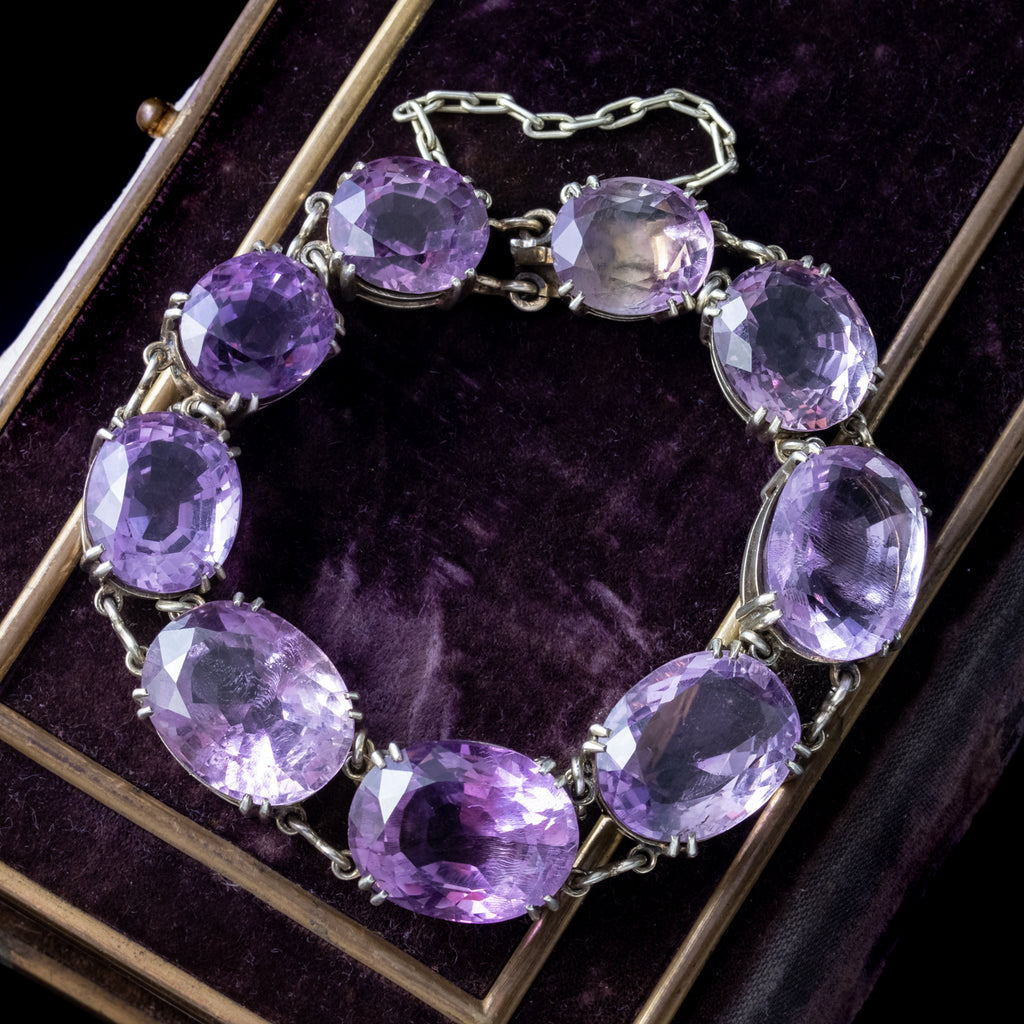
These beautiful purple stones have the unusual distinction of once having been considered amongst the most valuable in the world. Along with diamond, sapphire, ruby and emerald amethyst was once one of the “cardinal gemstones” whose value surpassed all others. It adorns many of the most beautiful pieces of Victorian jewellery, where it was treated with the same care and reverence as the other stones in the big four.
The discovery of massive reserves of amethyst in Brazil in the 19th century made it more abundant, and its value lessened, although gem-quality specimens are still some of the most beautiful stones in existence. Legend held that it could prevent drunkenness, and it is still used in the rings of Catholic bishops to represent their wisdom and sobriety.
You can view our collection of fine amethyst jewellery here.
Citrine

This honey-coloured gemstone was a favourite of Queen Victoria, and adorns many magnificent pieces of Victorian jewellery. Chemically it is almost identical to amethyst, but has been subjected to intense heat during formation. Deposits of amethyst can be found where heat has been unevenly applied and the same stone shows both the rich yellow and deep purple colours. This substance is known as ametrine.
Citrines are faceted when included in jewellery, and the stones are often quite large, giving a magnificent shining golden effect that is extremely pleasing.
You can view our collection of fine citrine jewellery here.
Pearl
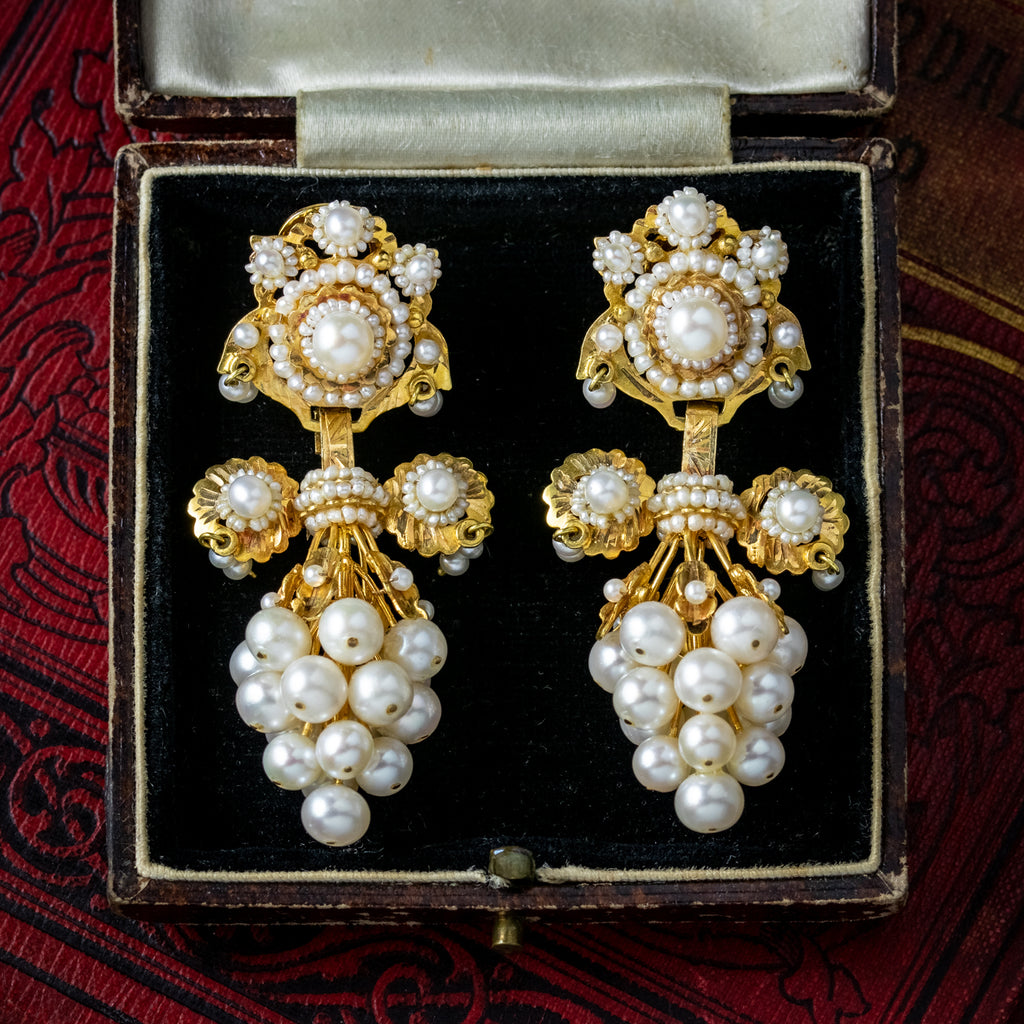
Pearls are not stones, they are formed within oceanic or freshwater molluscs from a substance known as nacre. When something irritates the soft flesh within the creature’s hard shell it coats it in layer upon layer of nacre, which hardens in a spherical mass which grows over time. These layers react to light in interesting ways, creating the optical effect known as pearlescence – a slightly translucent shifting set of subtle hues and projecting a fabulous lustre.
Pearls are most often white or cream, but can take on a wide variety of colours depending on the species of the creature which produced it and which body of water they lived in. Black pearls, for example, are often found in the waters around Tahiti.
You can view our collection of fine pearl jewellery here.
Jade
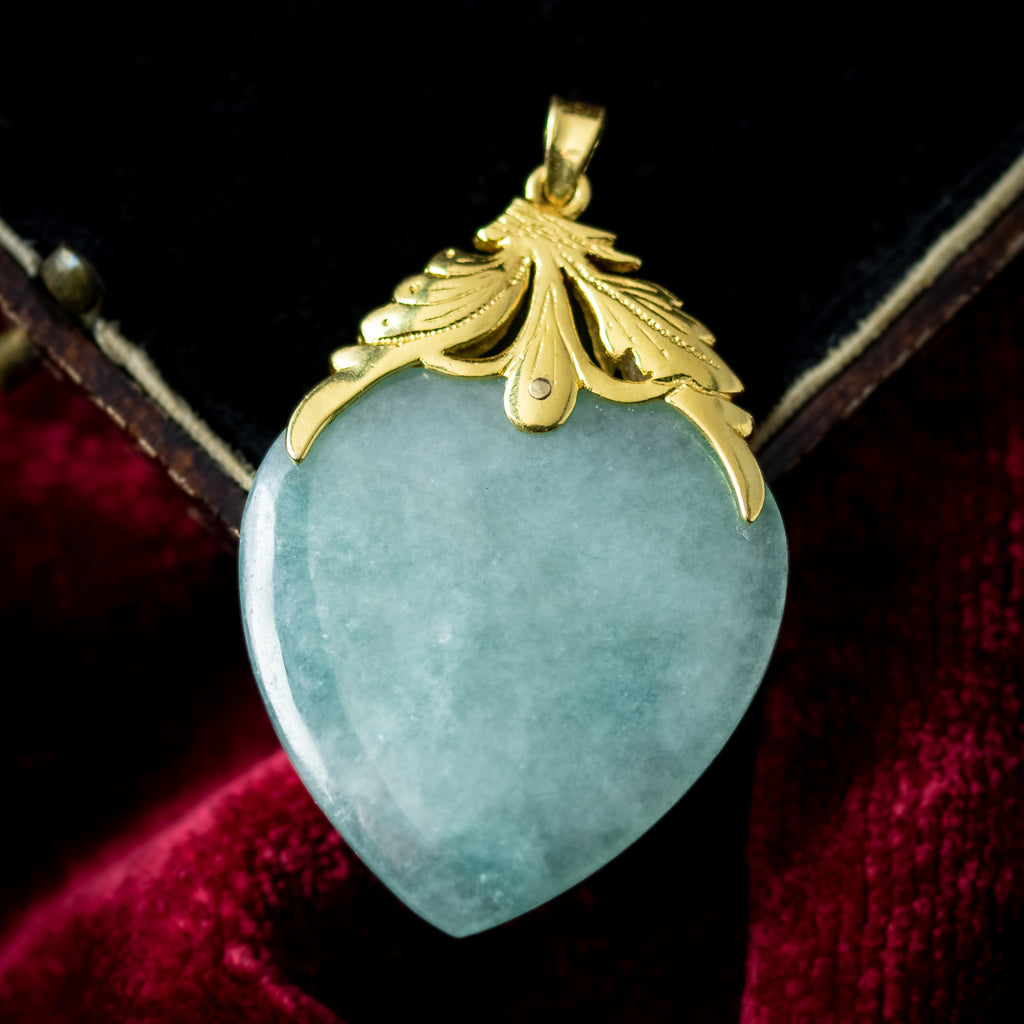
Although jade is known as a semi-precious stone in the west its value was unsurpassed in China and many other east Asian countries for much of their history. In fact when diamond was introduced to these nations its primary value stemmed from its ability to carve jade. The stone was associated with royalty, and was formed into a wide variety of incredibly shapes by extremely skilled craftsmen.
Jade is most often a shade of slightly translucent green, but it can form in a wide variety of starkly different colours, including red, purple, and the most valuable white.
You can view our collection of fine jade jewellery here.
Garnet

Most gem quality garnet is a deep red, although it can also be found in rarer green and rarest blue form. It has been highly valued throughout history, sometimes being mistaken for ruby and sometimes appreciated for what it truly is. The Victorians were fond of garnet and used it extensively in their jewellery.
It has been suggested that the garnet got its name from the same root as the pomegranate, whose seeds it superficially resembles
You can view our collection of fine garnet jewellery here.
Peridot
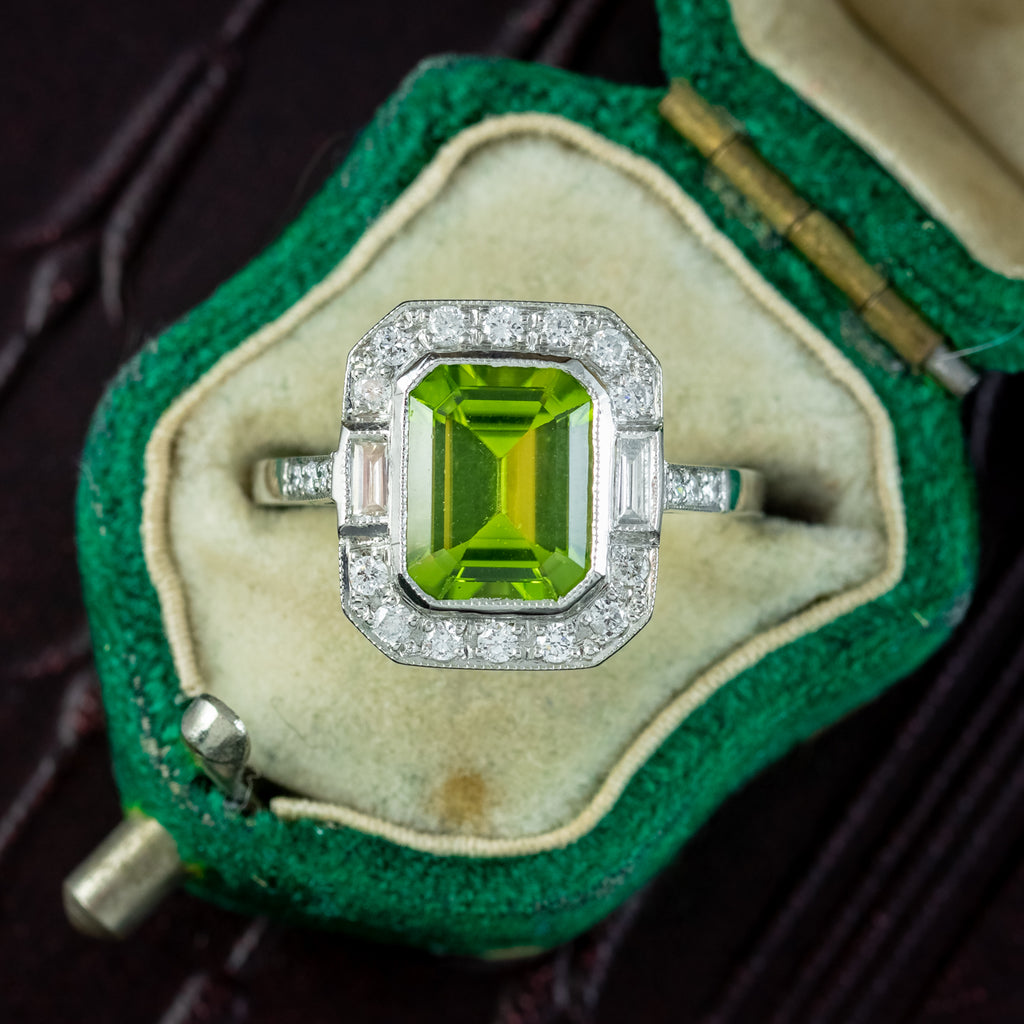
Known as the “evening emerald” the peridot is a bright green like summer sun on a grassy meadow. They are the gem quality variant of the deep green mineral olivine, which can be found on earth, but which has also been found in both meteorites and on other planets, including Mars and the Moon.
Peridot is most often used in Suffragette jewellery, which contains green, white and violet stones. The first letters of each colour stand for the Suffragette’s central message – “Give Women Votes”.
You can view our collection of fine peridot jewellery here.
Tourmaline

This tremendously varied gemstone. It can exhibit combinations of very different colours in bright or dark shades. It is believed to show the widest range of colours of any gemstone. Some types of tourmaline are banded in radically different hues, and are built into completely unique pieces of jewellery.
Tourmaline was only recognised as a unique gemstone in the early 1700s. Because of its range of forms it was often mistaken for other gemstones before this point.
You can view our collection of fine tourmaline jewellery here.
Carnelian

The roots of the carnelian’s name are somewhat disputed, but it is possible that it derives from the fact that it’s red/orange colouration looks remarkably organic. Carnis is the latin word for “flesh”.
Carnelian can be carved into fine patterns, making it ideal for the crafting of signet rings and fobs which were pressed into wax to seal important documents in the old world.
You can view our collection of fine carnelian jewellery here.
Topaz

Topaz is one of the most widely occurring semi precious gemstones, occurring in many different nations across the planet. It can be found in many different colours, including completely clear varieties. Yellow/orange topaz is known as “precious topaz” and is highly valued for inclusion in jewellery, although pale blue and pink topaz is also often used and there are gem-quality examples of every colour variety.
Jewellery crafted with topaz is often more affordable than other gemstones, and its variety of colours means that it can be a suitable substitute for more expensive gems. It is often paired with other similar alternatives, such as cubic zirconia, which imitates the qualities of diamond.
You can view our collection of fine topaz jewellery here.
Moonstone
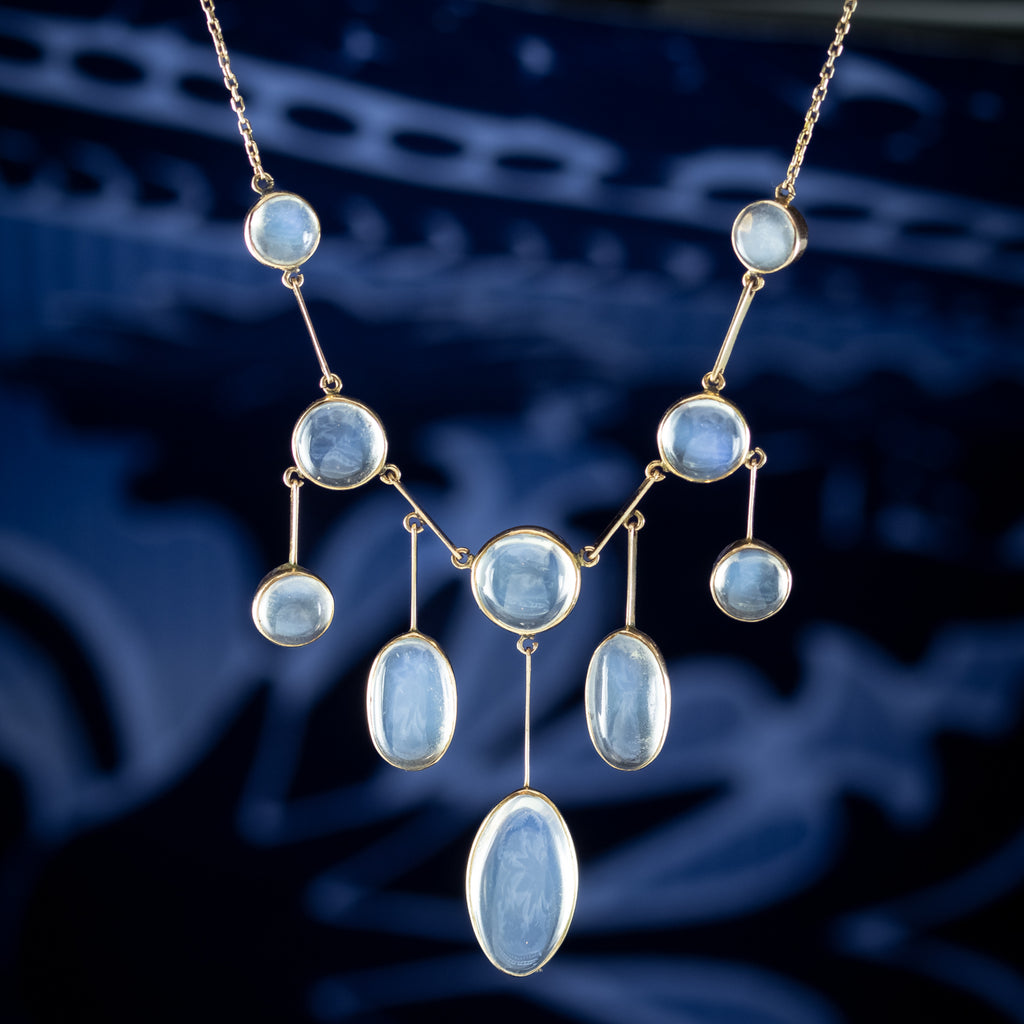
Most moonstone is a misty blue-grey colour which exhibits a shifting, billowy effect beneath the surface when light shines upon it. Its name stems from the ancient belief that the stone was literally solidified moonlight.
Moonstone is cut in cabochon for the same reason that opals are; this form maximises the visibility of the play of light within the stone.
You can view our collection of fine moonstone jewellery here.
Turquoise
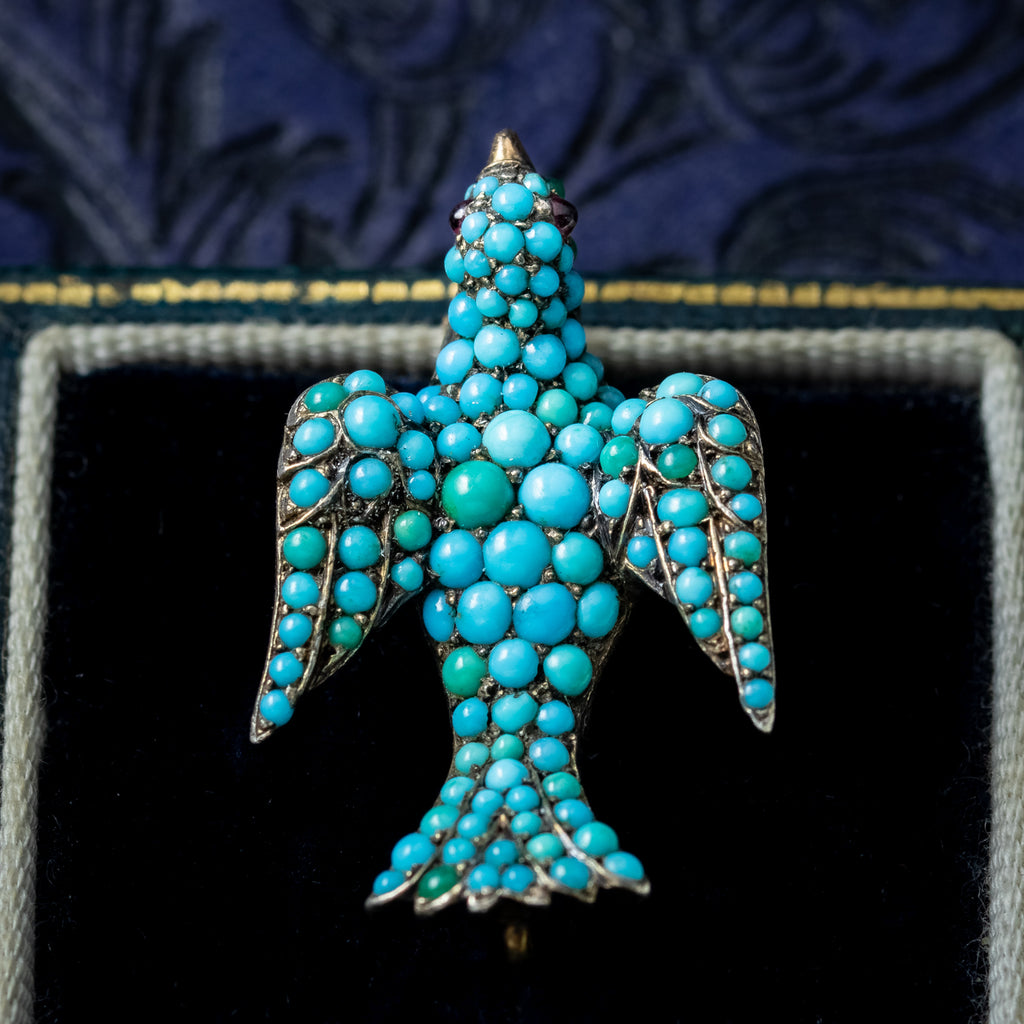
This gemstone’s unique opaque blue green colour is named after the stone itself, but the stone was named for the French word for “Turkish” as the first specimens to enter the west came from Turkey. Turquoise varies a little between blue and green, with bluer gems being more highly prized in the western world and greener variants more popular in the east.
Turquoise can also be found in a matrix form, where a web of dark host rock is also present, giving a unique pattern across the surface.
You can view out collection of fine turquoise jewellery here.
Agate

Agates are perhaps the most varied gemstone known to man. They form into a tremendous array of colours and patterns with hundreds of varieties discovered over the years. For this reason agate is also known as the “earth rainbow”.
Moss agate is clear with green inclusions which look like vegetation. Crazy lace, or Mexican agate, has a huge number of bands and circular inclusions in white, brown and black. Montrose agate is pale blue with darker bands laced through it. Agate is used extensively in Scottish jewellery, but it can be found in countless antique and modern pieces all around the world.
You can view our collection of fine agate jewellery here.
Spinel

Spinel is a crystalline mineral which occurs in a variety of colours and strongly resembles other precious stones. Many large and extremely beautiful gemstones, including some which were included in the British crown jewels, have been found to be spinels when tested with modern technology.
Red spinel is commonly mistaken for ruby as it has similar properties and colouration. In earlier times the line between these two gems was not clearly defined, and many specimens were known as spinel-rubies. It is only in the modern age that we can confidently label them correctly.
You can view our collection of fine spinel jewellery here.
Tanzanite

This intriguing gemstone was discovered in Tanzania in the early 1960s. It exhibits a striking colour shift known as trichroism, where the crystal can appear to be either blue, violet or deep red depending on the angle from which it is viewed. The intensity and exact nature of the colour shift is dependent on the placement, number and angle of the facets cut into the surface of the stone.
To date tanzanite has only been discovered in one location, and the government of Tanzania has taken steps to control how the supply is managed, meaning that it has become rarer and thus more valuable in recent years.
You can view our collection of fine tanzanite jewellery here.
Zircon

The clear varieties of zircon are often used as substitutes for diamonds, as they have a similar but not identical sparkle and are almost as durable. The most beautiful specimens are the blue variety, whose colour is renowned as being the brightest blue of all gemstones.
Although their names are similar zircon is not the same as cubic zirconia, a more common substitute for diamond which is prevalent in modern jewellery.
You can view our collection of fine zircon jewellery here.
Chalcedony
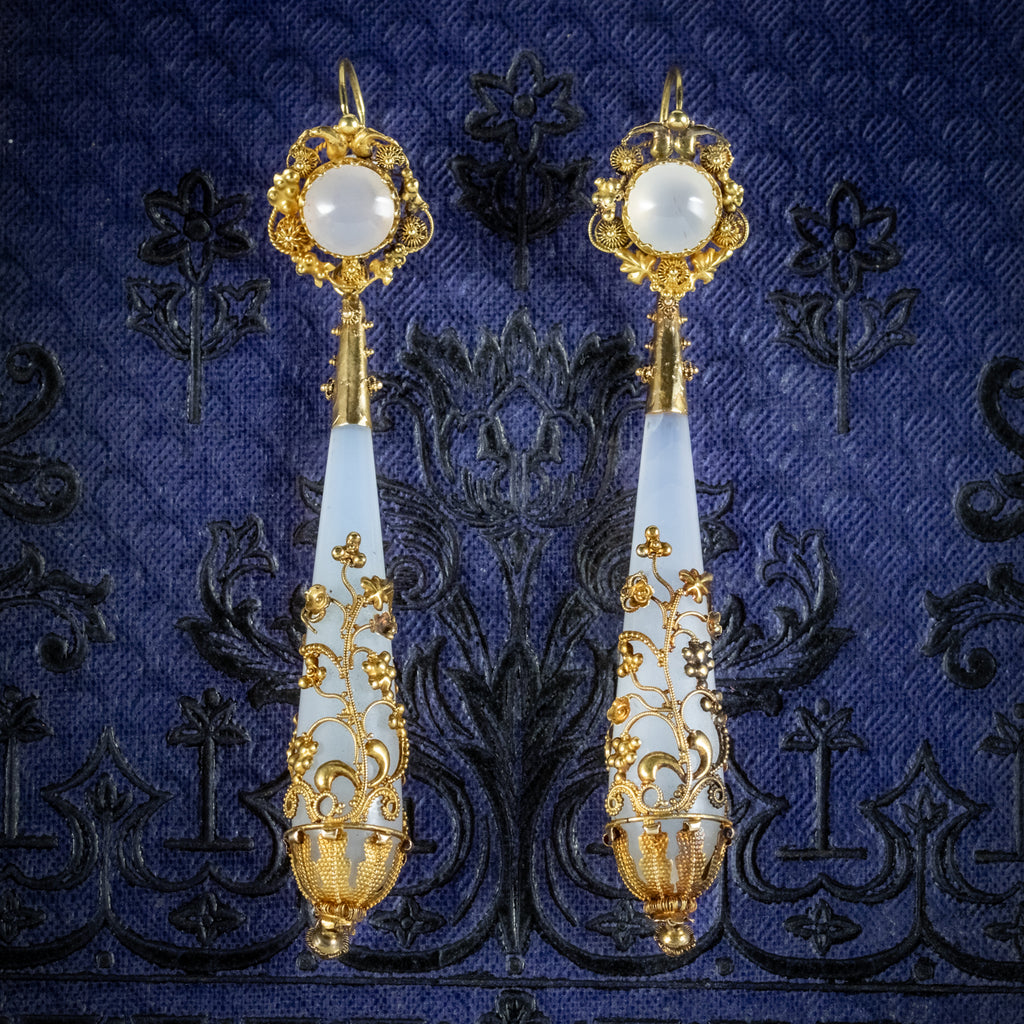
This colourful, waxy gemstone has been used throughout history for a variety of purposes, most commonly in the creation of seals as part of signet rings or fobs. Many other semi precious stones such as agate, carnelian and onyx are actually varieties of chalcedony.
Whilst the stone is not widely known in the modern age it is still extensively used in jewellery, where its opaque to semi translucent colours provide a distinctive and beautiful core to many interesting pieces of jewellery.
You can view our collection of fine chalcedony jewellery here.
Paste
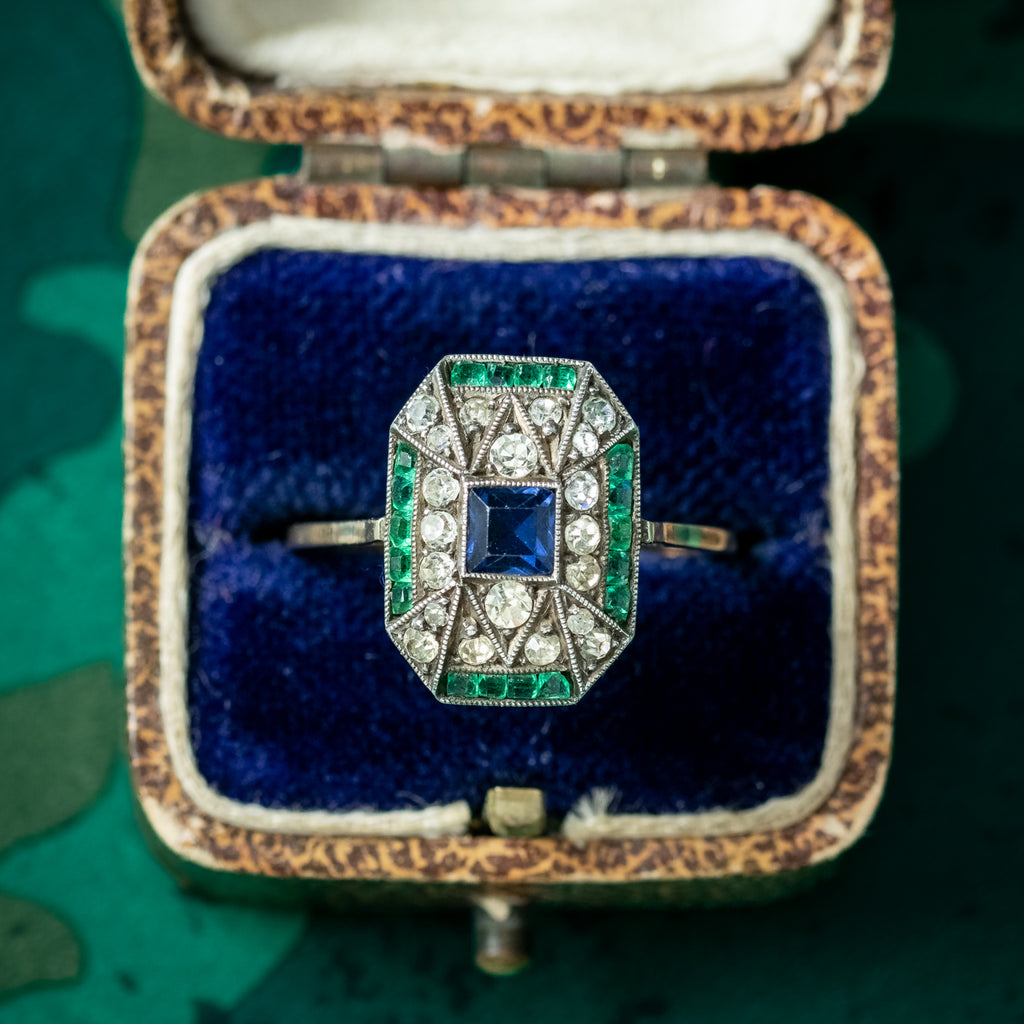
Paste stone is not a natural mineral, but a form of heavy glass that is man-made. The stone gets its name from the fact that it is prepared first as a viscous paste that is cooked to force it to harden and then faceted in a similar way to a true gemstone. The process of making paste stones is ancient, predating the Roman empire, although this was the time when it began to be widely used.
Many pieces of high quality antique jewellery contains paste stones, and in some cases the value of these pieces is actually higher than those with true gemstones. Due to their synthetic nature pastes can exhibit any colour, including those not possible to find in natural stones.
You can view our collection of fine paste jewellery here.
Looking for a particular piece? Why not get in touch and see what our team can do for you? Give us a call on England: 0333 700 4500; or drop us an email at enquiries@antiquejewelleryonline.com.

